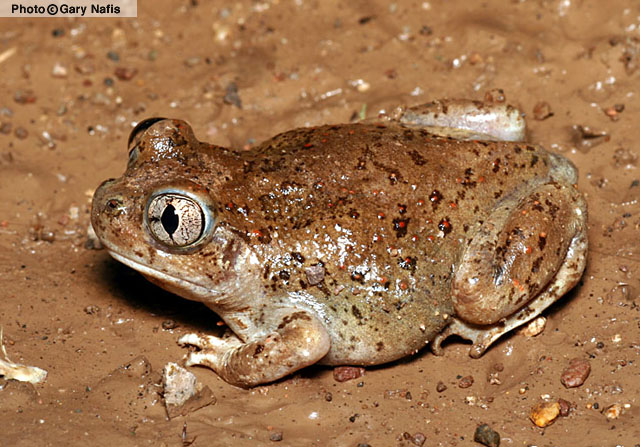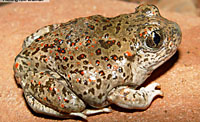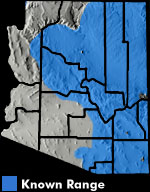Online Field Guide to The Reptiles and Amphibians of Arizona



Arizona
 Navajo Co., AZ |
| MEXICAN SPADEFOOT Spea multiplicata |
|
|
DESCRIPTION: Large adult Mexican spadefoots are about 2.5 inches in length. They are brown, grayish-green, or grayish-brown with dark spots or blotches on the back. Faint light stripes may be present on the back and sides, and red-tipped tubercles are scattered over the back and head. Like other spadefoots, the Mexican spadefoot has large eyes and a short wedge-shaped horny tubercle on the bottom of each hind foot, which it uses to dig its way into the ground. It is similar to the Plains and Great Basin spadefoots; but Mexican spadefoots lack a boss between the eyes (Plains spadefoots have a bony boss, while Great Basin spadefoots have a glandular boss). Mexican and Great Plains spadefoots smell like peanuts when handled (Plains spadefoots do not). Tadpoles have broad, flat heads with eyes high on the head. They can grow to nearly 3 inches, but most metamorphose before reaching 1.5 inches. Dorsally, tadpoles are light gray to olive or brownish-olive in color. Both carnivorous and omnivorous tadpoles occur; the former is induced by eating fairy shrimp and develop an exceptionally broad head, large jaw muscles, and a short gut. DISTRIBUTION: In Arizona, this species occurs over much of eastern and central Arizona, including areas east and south of the range of the Great Basin spadefoot, the Colorado Plateau, mountains of the Mogollon Rim country, and in southern Arizona from the Tohono O’odham Reservation east to the Peloncillo Mountains. HABITAT: The Mexican spadefoot is characteristic of a broad range of habitats in Arizona, from Sonoran Desert and Chihuahuan Desert scrub, and semi-desert grasslands to Great Basin Desert scrub, Plains and Great Basin grasslands, and coniferous woodlands in northern and central Arizona. It can be found on the edges of agriculture, particularly in southern Arizona. BEHAVIOR: Primarily nocturnal, but metamorphs may be active by day. This species remains buried in soil for months and then emerges with the onset of the summer monsoon season to breed. Post-breeding, Mexican spadefoots can be found far from breeding ponds and will stay active as long as conditions remain moist and warm. Individuals probably do not maintain territories. REPRODUCTION AND CALLS: This spadefoot breeds in temporary rain pools that fill during summer storms. The call is reminiscent of running a fingernail along the teeth of a comb. Males usually call from the middle of a pond, often swimming around without being anchored. Clutches average a bit more than 1,000 eggs and are laid in masses attached to vegetation or debris. Eggs hatch in 2-3 days and most tadpoles metamorphose in 12-19 days. DIET: Mexican spadefoots eat a variety of invertebrate prey, such as termites, ants, beetles, and spiders. They apparently avoid arthropods with toxins or chemical defenses, such as velvet ants and blister beetles. In the San Simon Valley about half the diet of Mexican spadefoots was found to consist of winged termites. REMARKS: Prior to the mid-1970s, the Mexican Spadefoot was considered a subspecies of the western spadefoot toad (S. hammondii) of California. Creation of stock tanks and places along roads and railroad tracks where water accumulates may have allowed this species to colonize areas that historically failed to provide standing water long enough for metamorphosis. The Mexican spadefoot hybridizes with the Plains spadefoot and rarely with Couch’s spadefoot. By Jim Rorabaugh Brennan, T.C., & Holycross, A.T. 2006. A Field Guide to Amphibians and Reptiles in Arizona. Arizona Game and Fish Department. Phoenix, AZ. Degenhardt, W.G., C.W. Painter, and A.H. Price. 1996. Amphibians and Reptiles of New Mexico. University of New Mexico Press, Albuquerque. Dimmitt, M.A. 1990. Biology of desert toads with emphasis on spadefoots. Sonoran Herpetologist 3(7):62-65. Morey, S.R. 2005. Spea multiplicata (Cope, 1863) Mexican spadefoot. Pages 519-522 in M.J. Lannoo (ed), Amphibian Declines: The Conservation Status of United States Species. University of California Press, Berkeley, CA. Stebbins, R.C. 2003. A Field Guide to Western Reptiles and Amphibians, Third Edition. Houghton Mifflin Company, Boston, MA. |
|
Visit Partners in Amphibian and Reptile Conservation:


HOME
Copyright © 2023, Arizona Game and Fish Department. All rights reserved.
If you make use of the textual contents of this site in reports, publications, etc. please cite and credit the author(s) and photographer(s). All photos on this website are copyrighted. However, those found in the species account section may be used for any noncommercial scientific, educational, or conservation purposes provided that photographs are not altered and continue to bear the copyright symbol and name of the photographer. Please contact the photographer regarding commercial use of copyrighted photographs.










